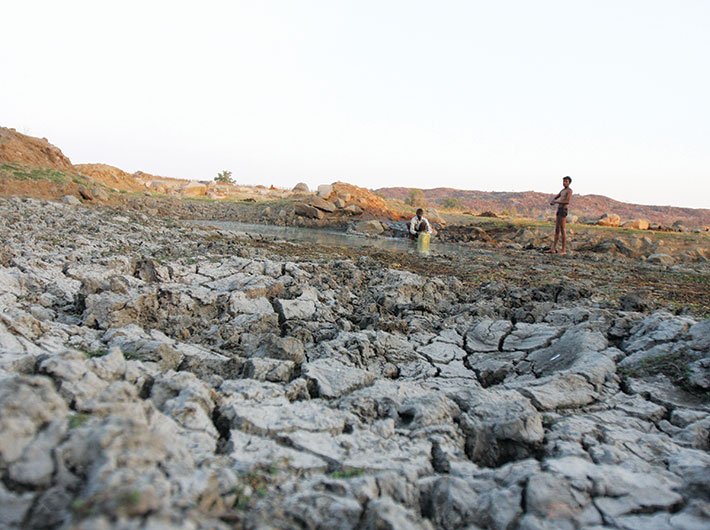Lack of rainfall is not the only reason for water shortage in several regions of the country. Uncontrolled lifting of ground water for unsuitable crops is also a cause
“The world has enough for everyone’s needs, but not everyone’s greed.”
– Mahatma Gandhi
This was an important advice given by the father of the nation, but our governments, it seems, did not bother to pay heed. The results turned out to be alarming: Several regions of the country are suffering from acute water crisis, making life sustainability a challenge for many. Undoubtedly, agriculture is the worst affected sector as crops which generate easy cash for farmers ask for more water.
One reason for this water scarcity in Maharashtra can be linked with the production of sugarcane. Marathwada, the state’s sugar belt, had declared a record production of sugarcane during 2014-15, despite a repeat drought after 2012 and 2014. Sugarcane is a water-guzzling crop, consuming over 70 percent of irrigation water, although it occupies just about 4 percent of farmed land in the state. The sugar lobby in Maharashtra, however, is very strong. Many leaders of the ruling and opposition parties have their own sugar mills or have shares in it. So, the governments frequently bail out sugar industries with subsidies and loan waivers. Most of the water saved in dams is legally, or illegally, used by these sugar mills.
And now, water scarcity is so severe that trains carrying water are sent to Latur district of Marathwada. Not just that, the situation has also posed a threat to law and order; the district administration of Latur imposed section 144 (unlawful assembly of people) of the Code of Criminal Procedure to prevent violence over water shortage.
Magsaysay Award winner and water activist Rajendra Singh, while talking to reporters in April, said the drought in Marathwada was not natural but man-made. He claimed that politicians of the state did not do anything for its people. Singh believed that sugarcane cultivation was responsible for the drought and farmers often ignored the large amount of water being utilised, from wells and tube wells, for cultivation of sugarcane. He suggested changing the crop pattern to overcome the water crisis and advised farmers to shift their focus from sugarcane to pulses which could survive even with moisture in air.
The Maharashtra government is now pushing for crop patterns that would be suitable for growth in drought-hit Marathwada region. Moreover, horticulture and floriculture under controlled water and temperature technology will also be emphasised to farmers.
Punjab is also suffering from water scarcity due to its erroneous crop pattern. Punjab is among the highest rice producing states in India. But high yielding varieties of rice normally require about 5,000 litre of water, on dry land, to produce one kg of rice. According to calculations of renowned economist Dr SS Johl, when Punjab had exported 18 million tonne of surplus wheat and rice in 2003-04, it was effectively exporting 55.5 trillion litre of water. It was during the green revolution that Punjab shifted from its traditional crops – mainly maize, pulses and oilseeds – to wheat-paddy cultivation, eventually leading to a drop in its ground water level.
According to the US National Aeronautics and Space Administration, India’s water tables are dropping at the rate of 0.3 metre a year. And according to the Central Water Commission’s estimates, live storage available in as many as 91 reservoirs of the country is 29 percent of the total live storage capacity.
Dr RS Sidhu, director (extension education), Punjab Agricultural University, Ludhiana, says, “Rice is not the traditional crop of Punjab. Paddy cultivation was started in the late 1970s and early 80s and currently, about 28 lakh hectares of land is under paddy cultivation. Water availability in Punjab shows that the state can afford only 16 lakh hectares of paddy cultivation, but farmers are not ready to change the crop pattern as there is profitability, guaranteed yield and an active system of minimum support price for paddy. Result is, about 110 blocks in a total of 145 are now declared dark zones. The whole of central Punjab is suffering from acute water crisis as paddy farmers have drilled tube wells in large numbers. The free power policy for farmers has made the situation worse.”
Dark zones are those blocks where the level of ground water drops significantly because of uncontrolled lifting of ground water for agricultural use.
While Dr Sidhu advocates a change in crop pattern, there is another viewpoint which is not ready to blame the farmers alone for this crisis. Himanshu, associate professor of economics at JNU, explains this crisis as short-sightedness of the whole system. “Why do we discuss the issue in the midst of the drought? Why is there no proper planning and advance preparation to face the challenge? Water table has been going down for years and cultivation of sugarcane and rice is also not new in water-scarce areas, but we have done nothing to change the atmosphere. There is a visible lack of planning on the government’s part,” he said.
According to Himanshu, a repeat of the drought in such a short period of time has worsened the situation. It has happened only four times in the last hundred years: One was before independence, the second in 1966-67 and third in 1986-87. The 2016 drought is the fourth in the list of back-to-back droughts.
“The country needs an effective agricultural policy with proper planning. We can’t blame farmers for their greed for cash crops. The government should invest hugely to enhance irrigation system. There are over 20 crops in the minimum support price list but only wheat and rice are on priority. Research to develop drought-resistant seeds is also very important. The government should give alternatives to farmers instead of sermons to discourage cash crop cultivation,” Himanshu adds.
feedback@governancenow.com
(The column appears in the May 1-16, 2016 issue)

